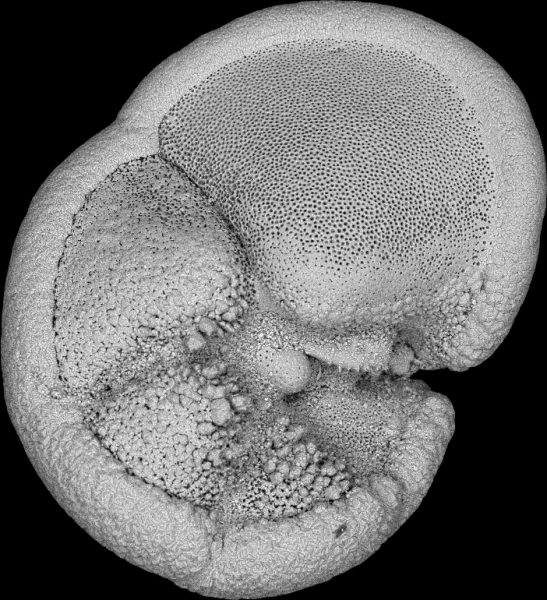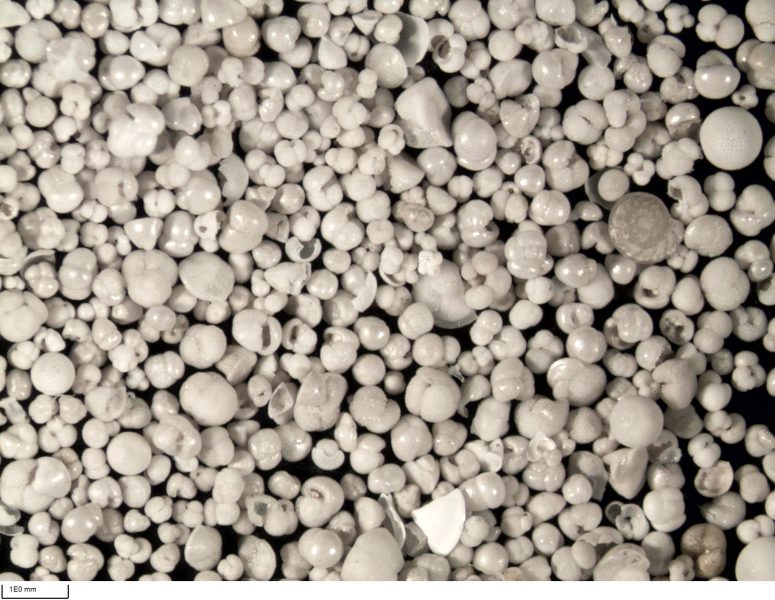New Study Shows How ‘Marine Revolution’ Shaped Ocean Life
April 29, 2025

Between 252 and 66 million years ago, the ocean underwent a revolution.
That’s when plankton with calcium carbonate skeletons colonized the open ocean. When they died, their remains fell like snow over large parts of the seafloor. The abundance of their skeletons over time changed the marine landscape, leading to unique rock formations and vast deposits of carbonate rock.
This buildup of carbonate minerals was an important part of the Mesozoic Marine Revolution, or MMR — a period of transformation in Earth’s oceans that helped set the stage for today’s modern marine ecosystem.
According to a new study led by researchers at The University of Texas at Austin and published in the Proceedings of the Royal Society B: Biological Sciences, the change in calcium carbonate dynamics in the ocean appears to have influenced the evolutionary trajectory of tiny but mighty sea creatures: foraminifera.
Foraminifera — or forams for short — have called Earth’s oceans home for hundreds of millions of years and are an important part of the food chain, making up 50% of biomass in deep sea ecosystems. But on the individual level, forams are very small. Each one is just a single cell surrounded by a shell-like skeleton.

Forams can make their skeletons out of different materials, including sediments and organic matter. The researchers found that after the MMR, calcareous forams — which build their shells by secreting calcium carbonate — flourished, going on to become the dominant type of foram living today.
The study’s lead author Katherine Faulkner, who conducted the research when she was an undergraduate student at UT, said that in addition to shedding light on foram diversity through time, the findings could help researchers learn about how other forms of marine life responded to swings in ocean chemistry over geologic time.
“Foraminifera are these very abundant organisms and they can actually tell us a little more about what other organisms that also have calcium carbonate structures might have been doing during this time interval,” Faulkner said.
Faulkner is now a graduate student at the University of Oxford.
In their study, Faulkner and her collaborators tracked the diversity of forams over the past 541 million years — a period known as the Phanerozoic — analyzing how different types of forams fared during big changes in Earth’s environment. This included multiple bouts of ocean acidification and five mass extinctions. The data on foram diversity came from a previously compiled index. The researchers compared this data against changes in ocean chemistry over time.
Before the MMR, calcareous foram diversity was particularly sensitive to environmental changes, with these forams having extinction and origination rates on an order of magnitude higher than other forams. These changing rates reflected big contemporaneous changes in ocean chemistry, rather than longer term trends.
After the onset of the MMR, however, calcareous foram diversity steadily increased while their extinction rates declined. What’s more, even when short-term changes in ocean chemistry during the Cenozoic Era led to extinctions, the diversity of calcareous forams rapidly recovered once conditions improved. The researchers attribute the rebound to the buffering effect of the increased amounts of calcium carbonate on the ocean floor.
“Foram diversity stabilizes more than I expected it would, especially with all the huge Cenozoic climate changes,” said co-author Rowan Martindale, an associate professor at the UT Jackson School of Geosciences’ Department of Earth and Planetary Sciences. “It’s impressive to me how that switch in the Mesozoic really transforms how forams react to changes in the ocean.”
The research highlights the variable ways forams have responded to changes in ocean chemistry over time and how the influx of calcium carbonate during the MMR helped calcareous forams weather environmental swings, said co-author Chris Lowery, a research assistant professor at the Jackson School’s Institute for Geophysics.
“You’ve got big changes in pH at the K/Pg boundary and the Paleocene Eocene Thermal Maximum, but there’s no real extinction [in forams] that we can observe in the latter record and certainly no big changes in [shell]-type through time,” he said. “It seems like forams on this scale are resistant to changes in ocean chemistry.”
Student Success: From UT Austin to Oxford University

It’s an accomplishment for any scientist to have their research published in the Proceedings of the Royal Society B: Biological Sciences. The journal is one of the top outlets for research on biological science.
The accomplishment is particularly impressive when the research was led by an undergraduate student.
“To have undergrads publish as lead authors, the students really have to be doing something special,” said Associate Professor Rowan Martindale. “You have to have an undergrad who is willing to see it through and take on the challenge of dealing with reviews and the heartache of rejection.”
Katherine Faulkner, who earned her Bachelor of Science in Environmental Science from The University of Texas at Austin in 2023, saw it through to the end.
She said the process of learning how to conduct research, along with going through the gauntlet of the publishing process, helped prepare her for graduate school at the University of Oxford.
“I definitely think working through this project really showed me the realities of research that I would not have experienced otherwise,” Faulkner said. “It also made me think more about the kinds of research that I would want to do.”
Faulkner is still studying paleoecology. Instead of tracking foram diversity over time, she is now focusing on reef corals in the Indo-West Pacific.
Faulkner was a recipient of the Jackson School’s Martin Lagoe fellowship for micropaleontology research. She credits the resources and support available at the school with helping her reach the next step in her research career.
“I’m very grateful for the fact that UT provided me with so many resources to get where I am now,” Faulkner said. “Rowan, Chris and everybody else who helped me throughout the journey really prepared me and I genuinely don’t think I would be where I am today without such a great support system.”
